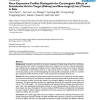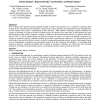174 search results - page 31 / 35 » Tracking People and Recognizing Their Activities |
105
click to vote
ICCV
2007
IEEE
16 years 1 months ago
2007
IEEE
An approach for incremental learning of a 3D scene from a single static video camera is presented in this paper. In particular, we exploit the presence of casual people walking in...
COMPUTER
2007
14 years 11 months ago
2007
ract in that they deal with sequences of sound or movement. Two social or personality skills can also be defined: Intrapersonal skill helps people perceive and control their own th...
JOCN
2011
14 years 6 months ago
2011
■ Agency attribution is a hallmark of mind perception; thus, diminished attributions of agency may disrupt social–cognition processes typically elicited by human targets. The ...
BMCBI
2006
14 years 12 months ago
2006
Background: Aristolochic acid (AA) is the active component of herbal drugs derived from Aristolochia species that have been used for medicinal purposes since antiquity. AA, howeve...
114
click to vote
IJMMS
2007
14 years 11 months ago
2007
How we design and evaluate for emotions depends crucially on what we take emotions to be. In affective computing, affect is often taken to be another kind of information - discret...


